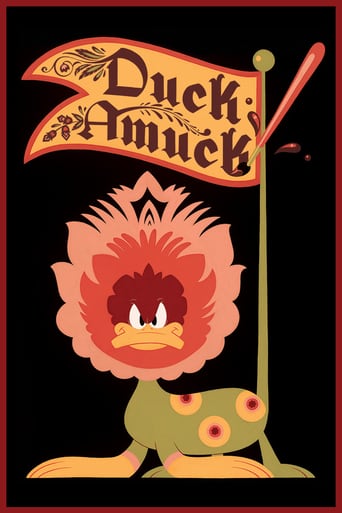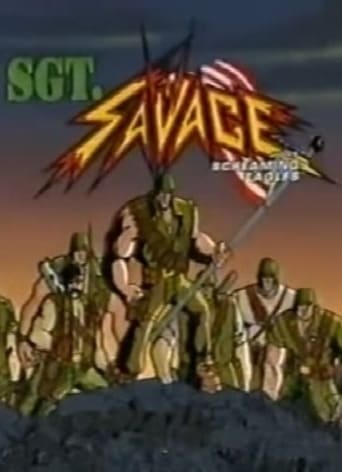WakenPayne
This is yet another piece of childhood nostalgia, Looney Tunes. After seeing a couple of them this one is easily my favourite. But then again I haven't seen that much since I was a kid so that can be a little problematic. Even as a kid I enjoyed this above most of them.The premise is take an animated character (Daffy) and put him in a situation where the background keeps changing time and place if it was there. All efforts to convince the animator usually end up in Daffy getting coloured, given a completely different and ridiculous body or other such ways to always make us laugh at his reaction.If you even have the slightest enjoyment of Daffy Duck or any of the other Looney Tunes characters then this one is certainly for you. Even after many years it always is fun to see him look at his ridiculous new body in a mirror and scream "EEK!"... Ain't I a stinker!
sashank_kini-1
Daffy Duck and Bugs Bunny are Looney Tunes' most recognized faces. Bugs Bunny is calm yet sly while Daffy is animated and hot-headed. In Duck Amuck, its Daffy's time to shine or rather get smudged, erased, abused, tormented, and blown! In a matter of six minutes, Chuck Jones delivers a tour de force short, with full (in) justice given to Daffy's character- be it its arms, legs, stomach, voice, face, even its tail. The opening scene, in which Daffy originally plans to take on enemies, is sword is interrupted by a white screen. Daffy himself seems perplexed, and whispers to the 'the guy in charge around here' to add some 'tschenry!' Every time the wrong scenery is added till Daffy gets fed up and confronts the creator. This is a genius part because when we look at it, we as audiences feel Daffy is talking to us as we laugh at his misery.My favorite moment is when Daffy tries to vent his anger but his voice changes. The way he gets agitated and embarrassed, with the constant gesticulations (clenched fist, hand on mouth, shaking hands) is a joy to watch. Another highlight is the ab(use) of the scenery with the vivid distortion of 'Close Up' and contortions in Daffy's character when he demands the creator to give him a body. I can now realize Chuck's intentions- with every little distortion created, Daffy still remains the main focus. When the creator 'erases' Daffy's character, we recognize his distinctive voice, when he gives Daffy an amorphous body, we recognize his bill, and even though his temper reaches boiling point, there is always a quirky touch to it (referring to the 'double duck sequence').The most inventive moment was when the screen literally falls on him and he keeps a stick under it to hold it. It's a pity such humor is missing now because most of the target audience would not appreciate it now. Even watching those Mickey Mouse shorts made in 1930s makes me wonder why the new animation focuses on being so 'realistic' and does not want to experiment? At least some shorts can come up on cartoon channels that tend to break the rules and give life to anything and everything ( in Mickey Mouse, even a steam engine was given life in one short!)Duck Amuck is where Chuck Jones' jackpot struck! My rating: 9/10
tedg
I have a small list of films I think are essential viewing. This is on it, only one of two allowed for that year.Looking at my list, there are a few animated shorts, and I think that makes sense. Animators can play games with narrative that wouldn't read in conventional presentations.This little think is only seven minutes long, but that space quite a few narrative folds are presented.Daffy is forced to be someone different as the animator changes his context. This we saw decades before with "Sherlock Jr," but Keaton's identity didn't change so radically. Here, the identities are movie stereotypes, in fact stereotypes that only exist in movies. But then Daffy is redrawn directly to be a different being, first in the same shape with different colors and then in a radically different shape, part flower. Flying from his tail/flagpole is a flag with a screw and a ball on it. Screwball comedy.Then we play with the animator manipulating the camera, far and close. Remember that this was the period of Hitchcock's developments of camera awareness, and the short may well have played in front of "Dial M" or "Rear Window."(Remember also that this was after the two similar cartoons that spoofed the rerelease of "Robin Hood," so the cartoon ABOUT movie notion was established.)Then we have the noir black curtain falling on our duck, protected temporarily by a prop, but he fights back against noir, first against the black curtain itself and then its cause, an unresolved ending. After this, we have the duck encountering a mirror image of itself and subsequently being destroyed, noir winning (as it always must). At this point in movie history, noir had. And finally, we zoom back in narrative space to see the cartoonist who has been manipulating the cartoon by pencil, brush and eraser that we see as themselves drawn elements. And behold, we see the narrator is... a cartoon character!Ted's Evaluation -- 4 of 3: Every cineliterate person should experience this.
Mightyzebra
This is probably the most clever and inventive short I have ever had the opportunity to watch. It shows Daffy Duck, being made VERY VERY ANGRY by being drawn into many different messes. Daffy Duck is perfect in this episode. He is well-animated, nice enough and gets angry easily when necessary (In some episodes, I feel as if he is being unnecessarily cruel and he's not in this one, he's trying to be nice!).This short also has some MASSIVE humour. Just when you have finished laughing, yet ANOTHER joke comes on - and of course - you HAVE to laugh again!Recommended for all Daffy Duck and cartoon animation fans! Enjoy!



